- Price: £ 95 ($189 Electronic Download)
- Supplier: VMware
- Web:
www.vmware.com
System Requirements:
Standard x86 compatible or x86-64 compatible PC;
733MHz or faster processor; 512MB RAM (2GB
recommended); Hard Drive; CD-ROM/DVD-ROM;
Ethernet Controller on host for Local Area
Networking; Windows Enterprise, Business,
Ultimate, Server 2003, XP Home, XP Professional,
Server 2000: Linux: Mandriva Linux 2006-2007,
Mandriva Corporate Desktop 4.0, Mandriva
Corporate Server 4.0, Mandrake Linux 10.1,
Mandrake Linux 9.0 – stock 2.4.19, Red Hat,
SUSSE, Ubuntu.
For many years now virtualisation software
has been the provenance of the software
developer and beta tester, whose sole need has
been a platform on which to test various
software applications and operating systems
without putting their PCs at risk from possible
crashes.
Without virtualisation software, operating
systems would have required, at best, a dual
boot scenario on separate partitions or hard
drives, and at most, individual PCs for each
operating system tested.
Fortunately, virtual machine software gave
developers' the opportunity to create virtual
computers within the confines of a single
machine enabling free movement between operating
systems without the need, as one now does with a
dual boot system, of closing down the main PC
and rebooting to use a different operating
system.
A Virtual Need
More and more general PC users have now
discovered the art of dual booting; the only
inconvenience being, of course, is the fact of
having to keep physically re-booting the PC.
VMware workstation is the de-facto virtual
machine application that can help users achieve
the ambition of running multiple operating
systems without the need for additional hard
drives, multiple partitions or, indeed, the
expense of additional PCs.
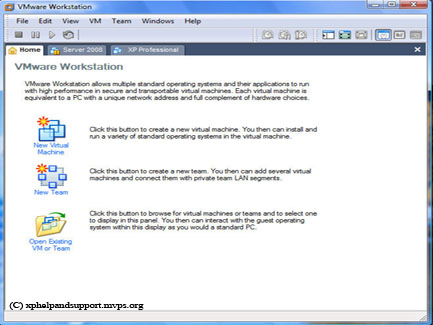
Fig: 1 VMware Start Screen
VMware workstation installs directly upon the
main operating system (referred to as the host)
with any additional operating systems the user
may wish to install (referred to as the guest)
being installed as files in a Virtual Machine
folder on the host machine.
Once the guest operating system is installed
it can be booted and run just as if it were a
totally independent PC.
Not just one pc, but many
VMware Workstation enables users’ with one
single PC to turn it into a number of virtual
PCs. The only obstacle as to how many virtual
machines that can be create is the amount of
available RAM and, of course, disk space.
For example, let’s say the host PC is running
Windows Vista - preferably Vista Business,
Enterprise or Ultimate ( Although it is possible
to install VMware workstation on Windows Home
Basic and Home Premium the Microsoft EULA (End
User Licence Agreement) does not allow Virtual
Machine software to be used on these editions) -
and that the PC has a total of 2GB of RAM (not
an unreasonable amount by today’s standards)
available, it would be quite feasible to run
Windows XP and Windows Server 2003 as guest
systems simply by allocating 512MB of the
available system RAM to each guest operating
system.
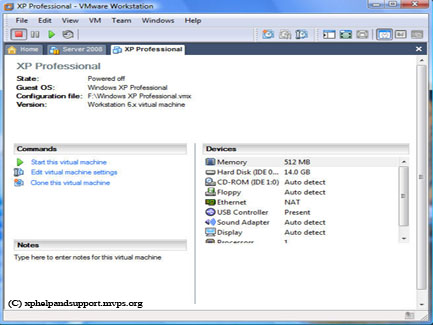
Fig: 2 Once the guest
operating system has been installed it can
quickly be launched from this window
Of course, the host operating system, has to
be running in order for the guest operating
system to run, but the user ends up with 3 PCs
in one, simply by using Virtual Machine
software. From the above scenario it is possible
to simultaneously run Windows Vista, Windows XP
and Windows Server 2003 (or an earlier version
of Windows or Linux) from the comfort of a
single PC.
Obviously, running three operating systems
simultaneously will affect the responsiveness
and general speed of the PC, but this in no way
detracts from the purpose and general usefulness
of VM software, and can easily be overcome by
either limiting the number of VMs running on the
relevant PC or, if possible, adding additional
RAM to the overall system.
Compatibility
With every new version of Windows there is
always the same hue and cry of ‘my current
software is not compatible.’ This isn’t an issue
with VM software, simply because it is possible
to install an earlier version of Windows as a
guest operating system on which any incompatible
software can be installed.
Because VMware workstation emulates graphics
and sound it is not yet possible for the Windows
Vista Aero graphics to be displayed if Vista is
used as a guest operating system. In this
instance the display will simply be the ‘basic’
display, which is very similar to Windows XP.
Operating System Support
Fortunately, VMware workstation has the
broadest support for host and guest operating
systems, being capable of running both Windows
and Linux operating systems as a host and most
desktop and server editions of Windows, Linux,
Solaris X86, Netware and FreeBSD as guest
operating systems.
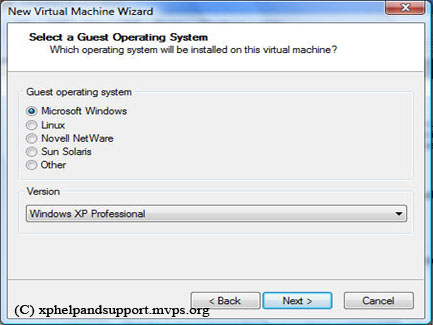
Fig: 3 Selecting the guest
operating system
You are not even restricted to 32Bit editions
of the operating system, either. The current
version of VMware Workstation happily supports
both 32Bit and 64 Bit operating systems as host
or guest.
Fully Configurable
Creating a virtual machine is simple using
the Virtual Machine Wizard.
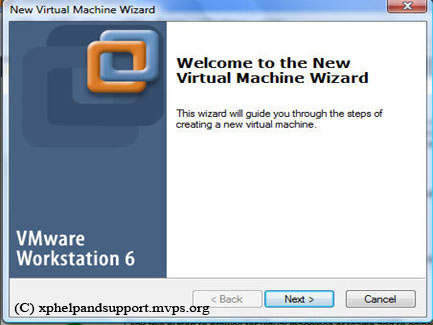
Fig: 4 The Virtual Machine
Wizard
The VM is fully configurable so the user is
in full control of such things as VM memory
size, disk, I/O devices and support for CD, DVD,
Floppy and Sound (emulates Creative Labs Sound
Blaster Audio PCI).
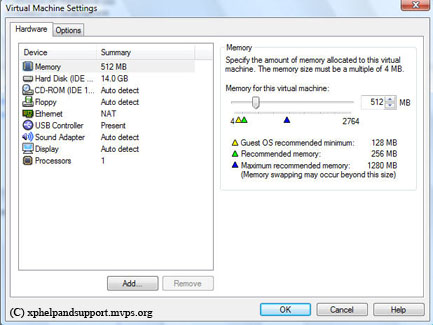
Fig: 5 By editing the Virtual
machine settings you can easily configure VMware
Workstation
With VMware workstation also supporting USB
2.0 devices removable hardware devices such as
USB printers, Webcam’s etc can easily be linked
via the host to the guest operating system.
VMware workstation also supports the use of
multiple monitors, giving the user an even
richer desktop experience. Unfortunately, MIDI
input, Games controllers and Joysticks are not
supported by VMware workstation.
Networking
VMware workstation is networked to the host
PC via a bridged, NAT, host only or customised
virtual networking connection, enabling the
guest operating system to have direct internet
and networking access via the host machine.
It should be noted, however, that because the
Virtual Machine is networked to the host machine
it is essential to install separate
antivirus/firewall (unless using Windows built
in firewall) and Spyware software on both the
guest and host PCs in order to protect both PCs
from any possible security breach.

Fig: 6 Guest operating system
open on host
Verdict
VMware Workstation is a simple but effective
alternative to dual booting or the safe testing
of operating systems that may compromise the
users main PC. Workstation is fully featured and
even includes drag and drop functionality (once
the VM Additions, a set of enhanced tools, has
been installed) between the Host and Guest.
Access to a second operating system is simply a
mouse click away; no longer is there any need to
reboot the PC simply to gain access to another
operating system. While VMware Workstation
doesn’t come cheap the savings on additional PCs
and hardware alone far outweigh its initial
cost; and as far as Virtual Machine software
goes VMware Workstation certainly out performs
the competition.
Rating
- Ease Of Use: 9
- Features: 9
- Value For Money: 9
- Overall: 9